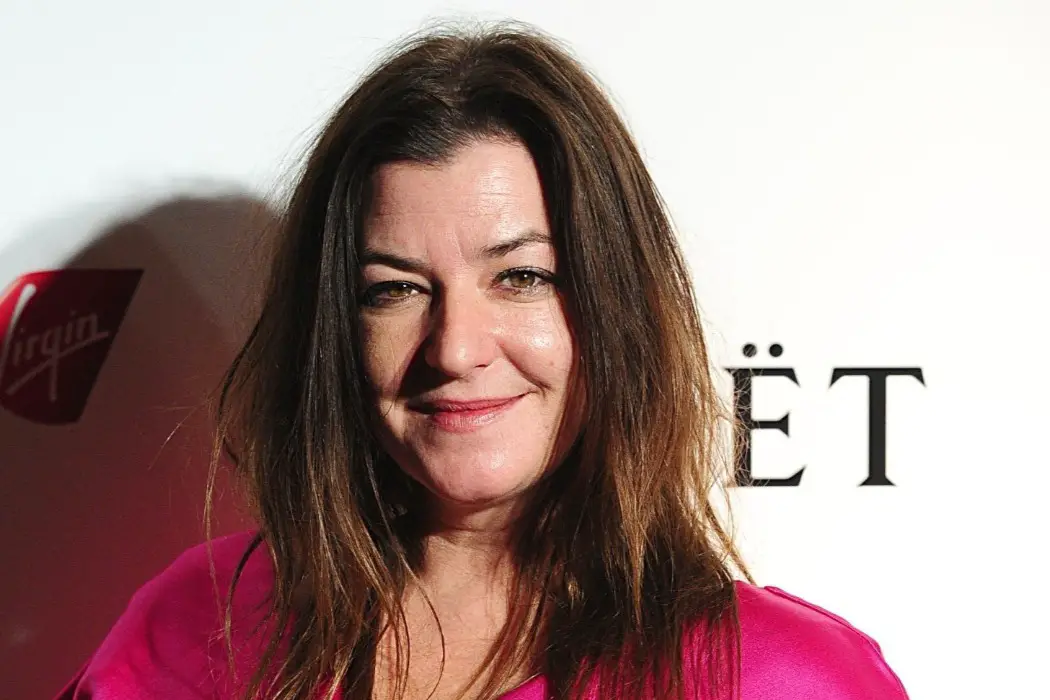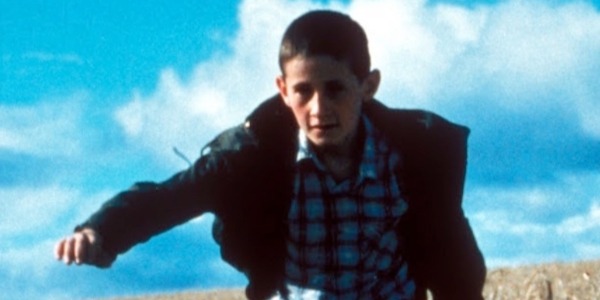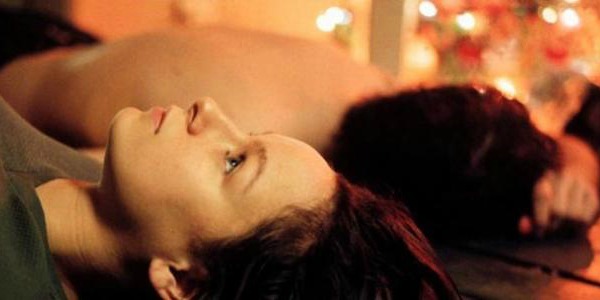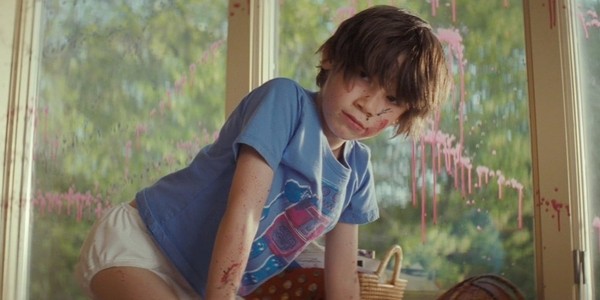Beginner’s Guide: Lynne Ramsay, Director

John Stanford Owen received his MFA from Southern Illinois University,…
Lynne Ramsay’s work radiates with a feverish, dogmatic obsession. For many filmmakers, their cinematic library amounts to an amorphous, shape-shifting cloud of moods and motifs, yet her films string themselves together through a shared thematic DNA. At this point, only four full-length features exist with her name at the helm, but in each one, that common thread stretches further.
How does human behavior de-evolve once consequences no longer exist?
That question encapsulates the tonal assonance that marries the tetralogy of Ratcatcher, Morvern Callar, We Need to Talk About Kevin, and You Were Never Really Here. In each title, the stories unfold amid moments that happen before and after lamentable acts occur, shedding light on the lead-up causes and surveying the emotional wreckage left once the terror ends. Leaving no character unexamined, these films crawl deep inside the psyches of both perpetrator and victim. But, if we’re being honest, the survivors don’t learn much, and that’s because there is no wisdom to mine from the tragedies that repeat and repeat and repeat.
So, what happens when a director stays doggedly put in their thematic lane? Why tell stories that navigate only the pitch-darkest elements of the human condition? After all, the auteur Robert Altman wedged the eccentric-yet-goofy Popeye into a collection of otherwise hyper-sardonic films. Even Stanley Kubrick, famous for exploring the twisted minds of those who live without concern for others, made a knee-slappingly funny comedy in Dr. Strangelove. But for Lynne Ramsay, thematic fidelity is an unbreakable clause in the contract she holds with her audience.
That contract has a name, and it exists in other narrative artworks, though perhaps not as such a vital element. Chekhov’s Gun (the principle that states if an author introduces a rifle in the first act, it needs to go off in the next) shines the guiding light in Ramsay’s scripts. When the first frames usher you into the story, she’ll show you the gun, and you can count on it firing. That’s the crucial promise she’s made throughout her career thus far.
Ratcatcher (1999)
There comes a moment in the dead center of Ratcatcher where James, the preadolescent protagonist played by unknown actor William Eadie, runs through a golden wheat field shining beneath a clear, sunny sky. This scene gives the audience a pop of chromatic vibrancy in a film so drained of color that it stands a few notches away from black and white. At a glance, this shift appears as tonal nuance, but instead the bright sequence projects a fantasy for what could be real if only the universe were kinder.

Daydreaming, especially that which happens in the minds of children, drives the film forward. And there’s a reason for that. We open with a scene of horseplay gone horrifically wrong; a child, James’ close friend, drowns in a dirty, trash-filled pond. We watch the cast of working class characters attempt to escape such darkness during a sanitation workers’ union strike. This setting creates a mise-en-scene of brim-filled trash bags piled higher each day, lining the sidewalks where Glasgow’s most impoverished children play.
The lack of garbage pickup summons a metropolis of rats that chew their way through the plastic liners, and with nothing else to play with, the neighborhood kids befriend these rodents. Among the gaggle of kids is Kenny, a child too young to comprehend despair. Tying his favorite rat, Snowball, to the string that tethers a balloon, Kenny dreams of his white-furred friend landing on the moon. Only through James’ imagination do we see the film’s most fantastical image: a rat that floats above the Earth and lands on the moon’s cratered surface, where it joins its friends to scurry about that dusty rock forever.
We know Snowball never makes it to the moon. We wonder if James will make it at all.
Morvern Callar (2002)
Upon its release Morvern Callar joined the ranks of Jane Eyre, Mildred Pierce, Barton Fink, and Oliver Twist as an eponymous work that documents a short and tumultuous time in the titular character’s life.
The film opens on Christmas morning with the tree short-circuiting and blinking in a way that casts a slow-paced strobe over our hero’s face. Morvern Callar, a supermarket employee played by Samantha Morton, wakes up as the lights turn her skin an array of primary colors, and soon we discover that, while she slept, her husband committed suicide. What follows in the next ninety minutes chronicles how Morvern attempts to deflect the grief through denial and hedonistic release, as if to say that when you dance or have sex with strangers or spontaneously scoot off for a Spanish holiday, sadness keeps its distance. Yet that shredding grief lurks close behind, locked in a basement and furiously pounding on the door.

No stranger to cinematographic lyricism, Ramsay unravels the grieving process through visual metaphor. Never will you hear her characters utter the words “I’m really depressed,” because exposition is a scarce, if not nonexistent, narrative device in her films. The director shows you what her subjects feel. While Morvern stumbles around the hazy aquarium of grief, even the christmas lights paint the atmosphere with a muted hue. Viewers witness several instances where the edges of the screen blur into a watercolor filter, and in those moments, you become wholly aware that you are watching the world through Morvern’s grief-tainted vision.
We Need to Talk About Kevin (2011)
The film opens with a faint sound, a syncopated tick not unlike the warning hiss of a coiled snake. Those rhythmic tones, growing louder as the camera dollies closer to a sheer curtain gusting in thick, piercing wind, it’s the lawn sprinkler oscillating. We know it means something, that ominous ticking, and when we find out, it breaks our hearts.
We Need to Talk About Kevin gives subtle nods to a number of Shakespeare plays but no allusion is executed more pointedly than with Eva, the grieving mother played brilliantly by Tilda Swinton, who scrubs at a red stain that no amount of elbow grease will erase. Though Lady Macbeth spoke the “out, damned spot” line, Eva is neither cunning nor ambitious, unless her goals include living a functional life and raising a son who doesn’t behave in a constant state of sociopathy. Kevin, seen at various ages, is the spot that won’t wash out, and throughout the non-linear film, Eva tries to either prevent or deal with the aftermath of a tragedy that has always been written in stone.

Kevin’s behavior never consists of uncontrollable outbursts or temper tantrums; instead his actions remain calculated, thorough, and strategically orchestrated. He has the full knowledge that someone will experience grievous, irreversible harm. This psychographic model fleshes out Ramsay’s thesis that, when a person fears no repercussions, turmoil ensues, and despite our best efforts, we may fail to stop disastrous behavior, especially when it comes from those for whom we’re responsible.
You Were Never Really Here (2018)
Watch You Were Never Really Here to see how arthouse meets grindhouse. An eclectic, multi-textured piece that manages to keep its gritty mood intact, the film plays as a collage of neo-realism, magical realism, and surrealism with a narrative that switches off and on between the goings-on inside the protagonist’s manic headspace and the bone-crushingly violent reality happening outside. To bring these thematic elements to life, Lynne Ramsay relied on method acting. In interviews, Joaquin Phoenix recalls the director asking him to listen to looped fireworks, an exercise that allowed him to understand the PTSD soundtrack playing in perpetuity inside his character’s frazzled, tired mind.
Despite its bleak subject matter, the film showcases no fetishization of violence, nor does it deify revenge fantasies. In fact, it is perhaps Ramsay’s tenderist film. Our protagonist Joe speaks softly while wielding the hammer he uses to cave in the skulls of men who abuse young girls. He cares for his aging, frail mother with such patience in between assignments that call for barbarism. Such brutality necessitates his position as a hired gun, a career for which he earns little money but that deflects the pain of his past.
Joe’s flashback sequences reveal a wrenching personal history: a father who beat his mother, a military service tainted with images of murdered children, an FBI career ended after uncovering a tractor trailer filled with stacked bodies. The noir atmosphere—the wet streets, the steam and smoke rising from sewer grates—serves as a reflection for both internal demons and real-life predators Joe seeks to vanquish. Walking the tightrope that separates life and death, he continues living, buoyed only through his ability and willingness to remove the disenfranchised from desperate situations.
Final Thoughts: How Lynne Ramsay Lets the Light In
If you’ve encountered any writing focused on this director, you’ve read the inevitable mention of The Lovely Bones, the multimillion-dollar picture released on big screens throughout the world. This film almost belonged to Lynne Ramsay, though instead it became a profitable but forgettable affair. It turns out that what many studios call creative differences this filmmaker describes in a much more acidic fashion:
“People started to call it ‘The Lovely Money.’ They were getting greedy around it. And I could feel the vibes. It became like the Holy Bible, I kept handing in drafts and I thought they were good, but it was like ‘But that’s not exactly like the book, the book’s going to be a success.’ That was the mistake they made with the project.”
(Source: interview, Indiewire)
The question of fidelity between literature and cinema springs immediately to mind. Three of her four films stem from contemporary novels, all of which crawled from the minds of living authors. I’ve yet to run across any claims from Jonathan Ames, Lionel Shriver, or Alan Warner that the adaptations of their books somehow sullied the story. To speculate, it is as though these writers abide by the notion that artists draw contracts for their audiences. In other words, there is an intent that the creator must complete.
To Ramsay, the refusal to compromise happens in the interest of keeping the promise she made early on. As an indie director, passing on a major release because it doesn’t gel with your artistic integrity takes something more than chutzpah. Refusing millions of dollars means a devout commitment to the storytelling craft; not to mention, an adherence to the thematic concerns she holds so dear.
And, of course, that theme weighs heavy. At times, watching these films feels like an exercise in hopelessness. But in showing us the cold reality, Lynne Ramsay reminds us that circumstances need not be so bleak. This proclamation makes itself clear when James from Ratcatcher dreams about mice scurrying about the surface of the moon. We become more and more aware of hope’s plausibility when Joe from You Were Never Really Here holds the hand of a man he has every reason to despise. In seeing the world as it is, we also catch a glimpse of how it could be. It’s Lynne Ramsay’s most pertinent sentiment, which is most accurately described through lyrics from the late Leonard Cohen: “There’s a crack in everything. That’s how the light gets in.”
Do you have a favorite Lynne Ramsay film? Let us know.
Does content like this matter to you?
Become a Member and support film journalism. Unlock access to all of Film Inquiry`s great articles. Join a community of like-minded readers who are passionate about cinema - get access to our private members Network, give back to independent filmmakers, and more.
John Stanford Owen received his MFA from Southern Illinois University, where he also taught English courses. When JSO is not penning reviews and essays on cinema, he's reading and writing poetry, walking with his dog, or dancing to Radiohead.













